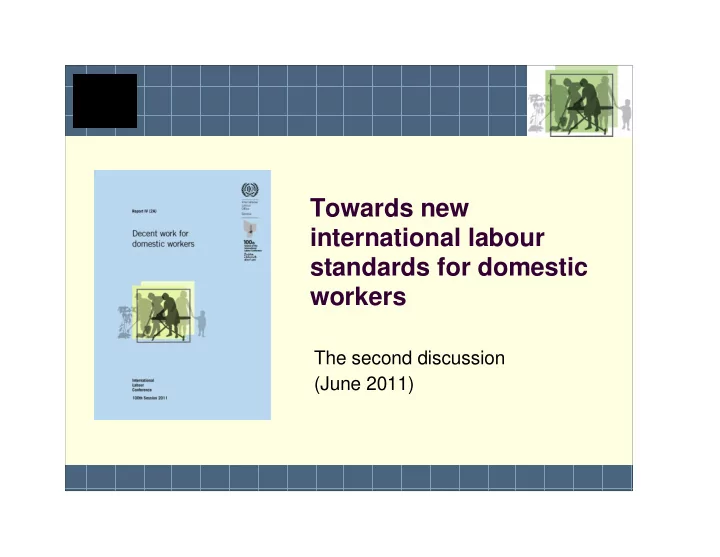

Towards new international labour standards for domestic workers The second discussion (June 2011)
Why new ILS on domestic workers? � Domestic work is invisible and poorly regulated � Inadequate legal protection results in sub- standard working conditions � Domestic workers are vulnerable to abuses of fundamental human rights
Why new ILS on domestic workers? � Domestic workers are predominately women and girls, many of them migrants and, as such, particularly vulnerable to abuse � Growing demand for domestic work (especially care work) across the world � Global minimum standards to facilitate closing of protection gaps
Increasing momentum Recent legislative and policy initiatives e.g. � in China, India, Indonesia, Jordan, Lebanon, Philippines, United States (NY), Zambia Increasing requests for technical assistance � from the ILO UN bodies call for action to better protect � domestic workers Need for a global reference framework �
The standard setting process March 2008 ILO Governing Body initiated procedure towards adoption of new ILS on decent work for domestic workers (double discussion) June 2010 The International Labour Conference (ILC) held the first discussion and adopted Conclusions Aug to Nov. Draft instruments prepared by the Office (“ Brown report ”) sent out to membership for comment 2010 March 2011 Publication of the “ Blue report ” containing summaries of comments received and revised draft instruments June 2011 ILC to hold second discussion with a view to adopting standards (Convention and Recommendation)
Brown report: replies A high response rate: Replies from constituents of more than 90 � ILO member States across all regions Replies also from the United Nations and � the European Commission
Brown report Government replies by region � Region Number of Replies Reply countries received (*) rate Americas 35 17 (26) 46% Africa 53 19 (10) 36% Arab States 11 8 (11) 72% Asia 33 9 (15) 27% Europe 51 37 (30) 73% Total 183 90 (92) 49% (*) number of replies to White report (questionnaire)
Blue report Report IV(2A) � Summary of comments received on the � proposed texts contained in the Brown report Office Commentary : explanations of � revisions to the draft instruments, and suggestions as to possible alternative wording Report IV(2B) � The revised proposed Convention and � Recommendation Basis for second discussion in June 2011 �
The proposed instruments Definitions Domestic work = work performed in or for a household � or households Domestic worker = person engaged in domestic work � within an employment relationship Excluded: persons performing domestic work only � sporadically or occasionally and not as a means of earning a living Scope All domestic workers � Possibility to exclude certain categories (flexibility � clause)
The proposed Convention Article Subject matter 1,2 Definitions, scope, flexibility clause 3,4 Human rights, child domestic labour 5 Fair terms and conditions of employment, decent working and living conditions 6 Information on terms and conditions, written contracts 7 Protection of migrant domestic workers 8 Protection from abuse, harassment and violence 9 Live-in domestic workers, identity and travel documents, privacy
The proposed Convention (cont.) Article Subject matter 10 Working time 11 Minimum wage coverage 12 Protection of wages, payment in kind 13,14 Occupational safety and health, social security 15 Access to dispute settlement procedures 16 Compliance mechanisms 17 Protection against abuse practices by employment agencies 18 Implementation of the Convention
The proposed Recommendation Paragr. Subject matter 2 Freedom of association and the right to collective bargaining 3 Discrimination, medical testing 4 Identification and prohibition of hazardous domestic work for children; protection of young domestic workers 5 Information on terms and conditions of employment, model contracts 6-12 Working time 13-15 Protection of wages, payment in kind 16 Accommodation and food 17 Termination of employment (live-in domestic workers)
The proposed Recommendation (cont.) Paragr. Subject matter 18, 19 Occupational safety and health, social security 20, 21 Additional protection of migrant domestic workers 22 Continuing development of competencies and qualifications, including literacy training Work-live balance needs Rights of domestic worker and general efforts for work and family reconciliation Collection of statistical data on domestic workers 23 International cooperation
The second discussion Issues identified by many replies for � further discussion include the following: Definitions and scope � Working time � Occupational safety and health � Employment agencies � Right to privacy �
ILC June 2011 Establishment of a technical committee, the � Committee on Domestic Workers Committee’s work: general statements and � amendment process Committee’s report , including proposed � instruments, to be adopted by Plenary Conference Drafting Committee to establish final � texts Final decision taken by Plenary record vote � (two-thirds majority required)
Recommend
More recommend